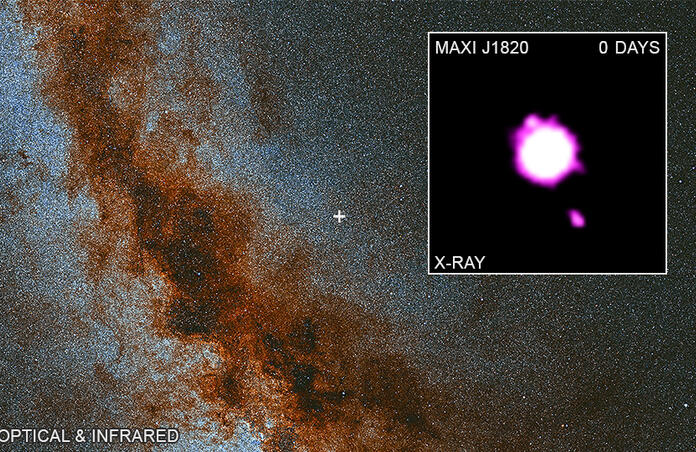Astronomers Observe Black Hole Blasting Jets Near the Speed of Light

Chandra X-Ray Observatory has recorded a stellar-mass black hole blasting out jets of material at nearly 80% the speed of light.
The black hole is about 10,000 light-years from Earth, dwelling in a system known as MAXI J1820+070 with its nearby companion star. It has a mass about 8 times that of the Sun, making it a stellar-mass black hole (one formed from the death of a massive star). The black hole is slowly absorbing material from the companion star, which causes an X-ray emitting disk of material to surround the black hole. As the material grows closer to the event horizon—the point of no return—it either falls into the void or is viciously blasted away in a focused jet along the black hole’s magnetic field lines. Astronomers have seen jets before on other black holes, but in this case, they’re firing material at nearly the speed of light.
MAXI J1820+070
NASA’s Chandra X-Ray Observatory initially captured data on the black hole and its jets from four separate observations spanning 2018 and 2019. A team of astronomers, led by Mathilde Espinasse of the Université de Paris, finished a new analysis of the complex data and published a paper in The Astrophysical Journal Letters (you can also find it online on Arxiv). They found that the black hole had expelled over 400 million billion pounds of material since the jets originated in 2018. The official press release on the Chandra website offered some great examples to put this amount into perspective: “This amount of mass is comparable to what could be accumulated on the disk around the black hole in the space of a few hours, and is equivalent to about a thousand Halley’s Comets or about 500 million times the mass of the Empire State Building.”

The team found more about the black hole after combining their analysis with data collected by Joe Bright of the University of Oxford, who studied the radio waves emitted from the jets during the entire year of 2018. They found evidence suggesting the jets decelerate as they get father away from the black hole. The team isn’t precisely sure why this occurs, though it may have something to do with how the particles in the jets interact with any surrounding material.
Stellar-Mass Black Holes
This isn’t the first time astronomers have discovered black holes with jets reaching near light-speed, this is still only the third discovery of its kind. Black hole jet behavior (and the black holes themselves) are still fairly mysterious to scientists. Observing MAXI J1820+070 and systems like it is vital to strengthening our understanding of these wildly chaotic objects, and now we’re one step closer!